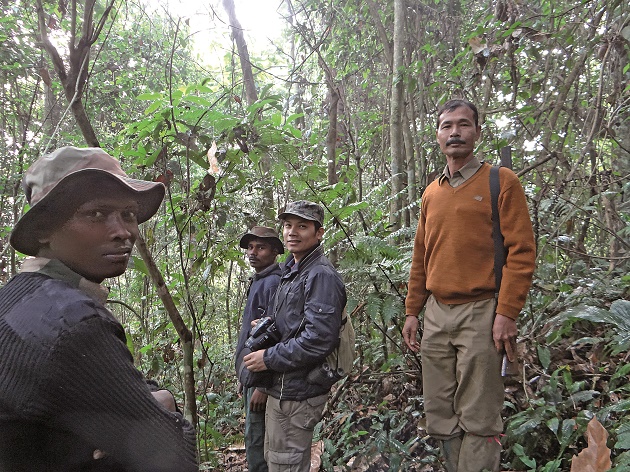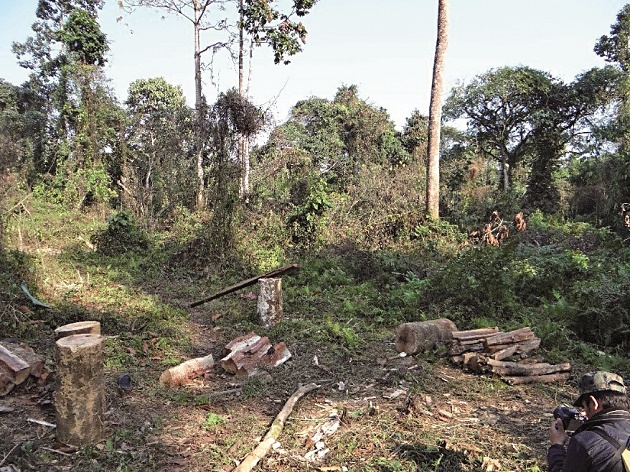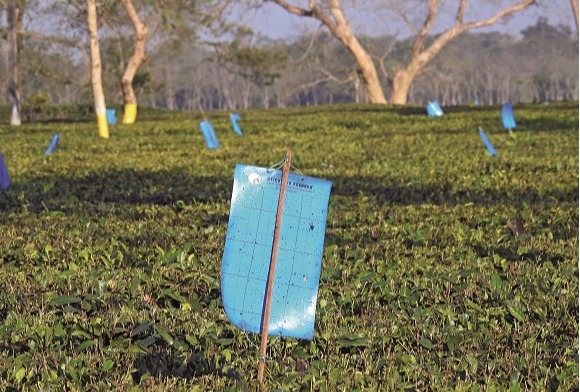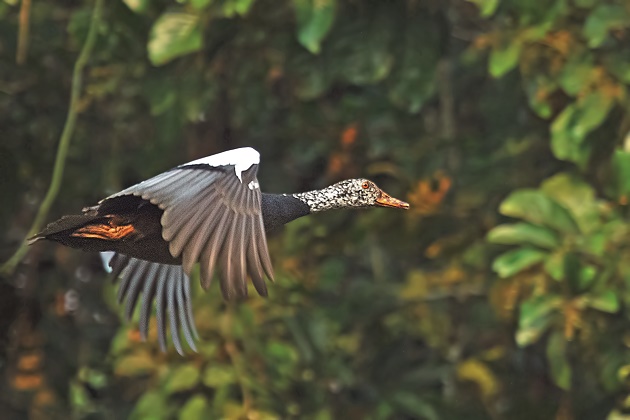The Quest for the Spirit Duck
First published in Sanctuary Asia,
Vol. 39
No. 4,
April 2019
By Keshab Gogoi
Dew drops descending from the sky-high canopies of giant Hollong trees refreshed us as we moved deeper into the rainforests of Dihing-Patkai. The forest was cloaked in darkness even at 7:30 a.m. We walked cautiously as Phukan, the forest guard accompanying us had warned, “Walk like the tiger, do not make any noise.” Phukan and Vijay Panikar, a local tracker, were leading us to a forest pool where they believed the spirits come down to forage. The canopy concealed the blue sky above us. There was no sign of human presence. The wet undulating terrain made it hard to move without holding on to nearby vegetation. Suddenly, a strange call, followed by a soft splash about 30 m. away placed us on high alert. “We just might be lucky today!” Vijay whispered. Through rising mists and dense vegetation, Vijay pointed at something in the water through a pinhole opening in the dense undergrowth. A whitish head, with amber eyes above a dark brown, heavy, streamlined body was swimming in the murky water. Two blue patches on either side with white primary feathers shining bright had Vijay whispering, “Deo Hanh!” (It’s a pair!).
Our search for the White-winged Wood Duck had actually started on a cold, evening in January 2017, in the Doon Valley. Inspired by Dr. Rashid Raza and Dr. Hafiz Shaeque Ahmad Yahya who had undertaken a survey in 1993 and Dr. Bibhab Kumar Talukdar who had completed his Ph.D. on the bird in 1995, we felt that a field survey was imperative and a plan was formulated within a day to set out in search of the bird.
A Past to Remember
Memories of tales told by my grandparents of how killing these sacred ducks would result in severe punishments, came to mind as we began to enter the world of the state bird of Assam whose myths and legends were narrated in virtually every Assamese home.
After getting the requisite permissions, we reached Tinsukia, the eastern-most district of Assam where Dr. Raza reminisced about his survey over two decades ago. Armed with the meticulous notes of his earlier trip, we set out for our adventure.
The first person we met, was Bhogeswar Baruah. A man of great dignity and humility, he was a forest guard in the Dangori Reserve Forest and had assisted Dr. Raza during the 1993 survey.
 The survey team break out into a smile on sighting the White-winged Wood Duck. This field survey in 2017 was designed along the lines of a similar survey conducted by Dr. Rashid Raza in 1993. Photo courtesy: Dr. Rashid Raza
The survey team break out into a smile on sighting the White-winged Wood Duck. This field survey in 2017 was designed along the lines of a similar survey conducted by Dr. Rashid Raza in 1993. Photo courtesy: Dr. Rashid Raza
When we arrived at the abandoned Ubhata Forest Camp site in the Dangori Reserved Forest, Dr. Raza and Baruah both spoke wistfully of their good memories. The pristine forest of tall Hollong and Nahor trees was badly damaged. Around the Dangori Reserved Forest, some wetlands such as Dubajan and Hanhsora ghuli had completely vanished. It was here that during the earlier survey as many as six White-winged Wood Ducks had been seen. The massive Hollong trees were gone and all we saw were saplings narrower than my wrist. A captive breeding population in the Kumsang Tea Garden no longer existed.
Once Upon a Time
In bygone days, the protected forests of Dibrugarh and Tinsukia districts were among the global hotspots for the rare bird. Hume and Marshall (1879–1881) in The Game Birds of India, Burmah and Ceylon reported that this was the fourth-most common duck in the 1870s after the Common Teal Anas crecca, Mallard A. platyryhnchos and Gadwall A. strepera in the upper Assam districts of Tinsukia, Dhemaji and Lakhimpur. In 1908, Baker called it one of the most common ducks but by 1925 Wright and Dewar said it was “nearing extinction.”
Since then the numbers have fallen still further, primarily because of the destruction of lowland tropical forests and hunting. The initial declines coincide with the major industrialisation of Assam in the late 1800s and early 1900s. The discovery of crude oil and expansion of tea gardens by the British destroyed the rainforests of Upper Assam. Huge swatches of forest lands were replaced by tea. The Promulgation of Wasteland Rule (1838, 1854, 1861) further decimated the forests, which were made available to the British at absolutely no cost. They were even exempted from paying land revenue for 75 per cent of their land-holdings and paid a mere pittance for the rest. In 1890, the total rainforest area cleared for tea was 131,280 hectares, concentrated in Upper Assam. When they discovered that the Assamese were essentially agrarian and severely depopulated by the inhumane atrocities of Burmese invasion, hunter gatherer Santhal tribes were brought in from Odisha and Jharkhand to work in the tea gardens.
 Rapid industrialisation and proliferation of tea gardens have replaced or degraded the pristine rainforests of Assam. Photo courtesy: Anne Wright
Rapid industrialisation and proliferation of tea gardens have replaced or degraded the pristine rainforests of Assam. Photo courtesy: Anne Wright
In 1889, the British established a crude oil refinery at Digboi, and the forests began to be polluted by oil and its environs reverberated to the sound of drilling units. Even on our survey, we saw several small forest pools, critical habitats for the White-winged Wood Duck, contaminated by oil spills. Such forest pools typify the unique Dihing-Patkai rainforest.
Of course, we also saw tea garden workers form groups of 5 to 12, going out armed with bows and arrows and hunting dogs. They are also known to use home-crafted guns to bring down large animals such as sambar.
 Rapid industrialisation and proliferation of tea gardens have replaced or degraded the pristine lowland tropical forests and rainforests of Assam. Photo courtesy: Keshab Gogoi
Rapid industrialisation and proliferation of tea gardens have replaced or degraded the pristine lowland tropical forests and rainforests of Assam. Photo courtesy: Keshab Gogoi
There is little the poorly-equipped Upper Assam forest staff could do. What is more, forest boundaries run along tea gardens making it easy for anyone to enter from multiple directions, then escape back into the coppices and proprietorship of the gardens.
We were, essentially in a ‘Green Desert’, a place devoid of the vast numbers of wild animals that once inhabited this rich land. Here and there, when we saw people sitting under trees, we also saw catapults next to them, right next to boards tacked to trees proclaiming wistfully: ‘No Hunting’.
Overcoming the Problems
The White-winged Wood Duck is vanishing, because its rainforests are vanishing. Helping the birds along their route to oblivion, are hosts of locals who consume both eggs and ducklings. This probably did little harm when forests were intact and wildlife was plentiful. Today, particularly during the breeding season, the birds desperately need protection. But, unlike the Amur Falcons of Nagaland, the White-winged Wood Duck has found no champions. Locals are unaware of the rarity of their heritage duck. When we spoke to them, some expressed genuine regret and emotion. If this glimmer of regard could somehow be fanned, community participation efforts could undoubtedly help return the species from the brink.
 A joint effort by conservationists, communities and policy makers is required to save this bird, once commonly sighted in Assam, from extinction. Photo courtesy: Vishwatej Pawar
A joint effort by conservationists, communities and policy makers is required to save this bird, once commonly sighted in Assam, from extinction. Photo courtesy: Vishwatej Pawar
This, however, needs dedication on the part of conservationists, involvement of young locals, and an awareness campaign that seeks to restore pride in their living heritage into the community. To this end, we would need to find ways to enhance their economic conditions by tapping into sustainable livelihood options including tourism.
Assam is not over the brink. There is still hope. Apart from Dihing-Patkai, other reserve forests in the region do continue to suffer habitat destruction, but these proud people are a delight to work with and the youth are surely our best hope for tomorrow. Many could be absorbed into the Forest Department. Others could earn dignified livelihoods as naturalist-guides. But until this very welcome development takes place, the Forest Department would need to be exhorted to conduct intensive patrolling to prevent illegal activities. Someone needs to speak to the owners of tea gardens and explain to them that they too must see the writing on the wall, and become a part of the defence team for wild Assam.
White Winged Wood Duck
The species was first described in 1842, by S. Muller from Java and named Anas scutulata, which was changed to its current description as Asarcornis scutulata by Rasmussen and Anderton in 2005. Two subspecies of the duck are known – A. scutulata leucoptera in Indonesia and A. scutulata scutulata in the rest of its distributional range. It is a non-migratory bird, foraging in small forest pools and slow-flowing forest streams amongst tropical moist/swamp forests. It usually appears in pairs, does not form flocks and is sexually dimorphic. The male is significantly larger than the female and has fewer dark spots on his neck. It builds nests in hollows and boughs of old mature trees, about 3-12 m. above the surface, mostly near water. Egg-laying begins in March and continues until June, while hatching takes place from April to July. The villagers around the Dehing-Patkai rainforest reported that during the incubation period, breeding females lose their feathers, and remain with the ducklings in the swamps throughout the monsoon.
Author: Keshab Gogoi


 The survey team break out into a smile on sighting the White-winged Wood Duck. This field survey in 2017 was designed along the lines of a similar survey conducted by Dr. Rashid Raza in 1993. Photo courtesy: Dr. Rashid Raza
The survey team break out into a smile on sighting the White-winged Wood Duck. This field survey in 2017 was designed along the lines of a similar survey conducted by Dr. Rashid Raza in 1993. Photo courtesy: Dr. Rashid Raza Rapid industrialisation and proliferation of tea gardens have replaced or degraded the pristine rainforests of Assam. Photo courtesy: Anne Wright
Rapid industrialisation and proliferation of tea gardens have replaced or degraded the pristine rainforests of Assam. Photo courtesy: Anne Wright Rapid industrialisation and proliferation of tea gardens have replaced or degraded the pristine lowland tropical forests and rainforests of Assam. Photo courtesy: Keshab Gogoi
Rapid industrialisation and proliferation of tea gardens have replaced or degraded the pristine lowland tropical forests and rainforests of Assam. Photo courtesy: Keshab Gogoi A joint effort by conservationists, communities and policy makers is required to save this bird, once commonly sighted in Assam, from extinction. Photo courtesy: Vishwatej Pawar
A joint effort by conservationists, communities and policy makers is required to save this bird, once commonly sighted in Assam, from extinction. Photo courtesy: Vishwatej Pawar